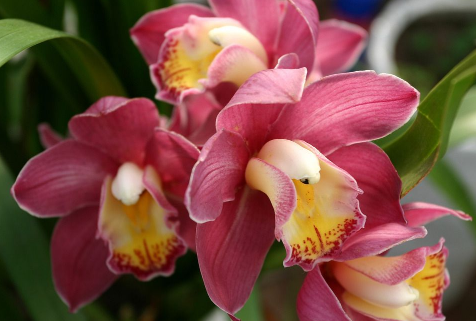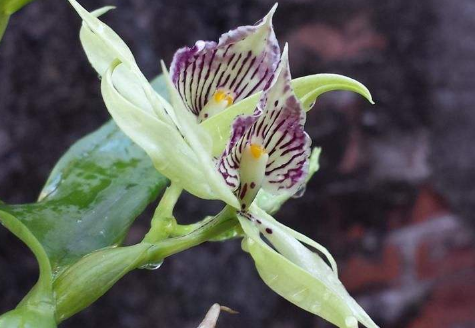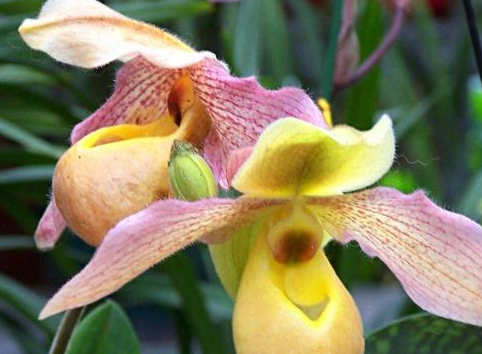Matters needing attention in the Culture of Cymbidium
1. Cymbidium is originally a plant growing in mountainous areas at high altitude. it requires high ventilation conditions and should be protected in a cool place.

two。 Cymbidium can not be watered too often, the soil can be properly dry, watering flowers and leaves must be a small amount, or let the water be dried quickly, too much water flowing into the center of the leaves will affect plant growth.
3. The root system of Cymbidium is relatively strong, and it is generally not necessary to turn the pot frequently in order for Cymbidium to have a stable growth environment.
Matters needing attention in the Culture of Cymbidium
Cymbidium is the most fertile of all kinds of orchids. In terms of fertilizer spraying, we must not be careless. The flower bud differentiation period of Cymbidium is from August to September, and there must be obvious temperature difference in order to promote flower bud differentiation, that is, about 25 ℃ in daytime and 12-15 ℃ at night. During this period, pay attention to temperature and fertilizer.
The germination of Cymbidium requires high temperature. If the temperature exceeds 15 ℃ at night, it will cause the flower bud to wither. In addition, it is also important to pay attention to that good ventilation is a favorable condition for the growth and development of Cymbidium. If there is no timely ventilation, especially in summer, it is not conducive to the normal growth and development of Cymbidium, affecting the differentiation of flower buds, resulting in the phenomenon of only long leaves but no flowering, which is very sad.
It is necessary to learn the matters needing attention in the cultivation of Cymbidium, especially if the family has planted Cymbidium, if your family does not blossom, there may be something wrong with the breeding method. Earlier, a friend asked the editor if Cymbidium didn't blossom. Did you find the reason? That's all for today. Thank you for reading!
Culture of Cymbidium and matters needing attention
Cymbidium is one of the flowers, Cymbidium is an artificial hybrid of Cymbidium, the flower language of Cymbidium: rich and peaceful, noble and graceful. What is the culture method of Cymbidium? What are the matters needing attention in the culture of Cymbidium? Below, the editor will take you to understand some of the breeding knowledge of Cymbidium. Let's have a look. I hope it will be helpful to you.
Cymbidium culture
According to the conventional methods of potting and changing pots in Cymbidium culture, when the plant is too large, the pot should be changed or ramet pots should be put on the pot to promote growth and flowering. Upper basin or change basin should be carried out after flowering or when the new buds are just sprouting in early spring. The method of changing the basin: pour the plant out of the old basin, cut off the rotten roots and yellow leaves, and remove the old matrix; put a layer of broken tiles or bricks at the bottom of the new urn to facilitate drainage and ventilation; put the plant in the basin, fill it with the new substrate, compact it with your hands and pour water through it. The watering method of Cymbidium culture Cymbidium is a flower that needs more water, especially in summer, it not only needs sufficient water, but also needs to spray water to the leaves to cool down and increase humidity. The inflated pseudobulb of Cymbidium has the function of water storage, so it has a certain degree of drought tolerance. But if it is not watered enough, the inflated pseudobulbs will shrink and affect normal growth. In addition, watering should be reduced during flowering, otherwise the flowers will appear brown spots. Temperature requirements for Cymbidium Culture
Cymbidium prefers warm, cool, humid and semi-overcast environmental conditions. The suitable temperature for growth is 15-25 ℃. If the temperature is lower than 10 ℃ or higher than 35 ℃, it is better to go dormant, and the overwintering temperature should be no less than 10 ℃. The flower bud differentiation of most varieties can be carried out smoothly when the temperature difference between day and night is less than 10-15 ℃.
Matters needing attention in Cymbidium Culture
Breeding precautions of Cymbidium grandiflora 1. Propagation: the method of ramet propagation is often used, which takes more time than after the plant blossoms and before the new bud grows, this short dormancy period is carried out. It should be properly dried before ramet and operated when the roots are slightly whitish and soft. Those with strong growth usually split once in 2-3 years, and each clump of orchid seedlings should have 2-3 pseudobulbs, one of which must be newly formed in the previous year. 2. Temperature: it likes strong light, and the suitable temperature for growth is 10 ℃-25 ℃. It should be cultured in a greenhouse with low temperature in winter. 3, humidity: it likes to be wet very much, but it should pay attention to ventilation, otherwise it is easy to get anthracnose, the humidity of small seedlings should be 80%, and the humidity of medium and large seedlings should be 60% to 85%. 4. Fertilization: the ratio of nitrogen, phosphorus and potassium is 1:1:1 in the growing period, 1:2:2 to 3 in the flowering stage, and the pH value of the fertilizer solution is 5.86.2. 5. Watering: sprinkler irrigation is usually used in production, once a day in May and September, twice a day from July to August, and every 2 to 3 days from October to April of the following year. The watering times should be adjusted at any time according to the size of seedlings and weather conditions.
- Prev

Culture method of octopus orchid
1. Octopus orchid soil requirements are not high, to use loose breathable fertile soil, generally choose fine particles of volcanic rock, bark or fire soil, can also buy special culture soil cultivation. 2. The temperature octopus orchid mostly grows in the forest at an altitude of 2000m, and has strong temperature adaptability.
- Next

Propagation methods of Paphiopedilum
Ramet propagation is the main propagation method of Paphiopedilum. Potted Paphiopedilum can be divided once every two or three years. Generally, there will be a short dormant period after flowering, and it can be divided at this time. First of all, take the plant out of the pot and clean up the soil from the roots so as not to hurt the buds. Separate the plants, each with two or three buds
Related
- Fuxing push coffee new agricultural production and marketing class: lack of small-scale processing plants
- Jujube rice field leisure farm deep ploughing Yilan for five years to create a space for organic food and play
- Nongyu Farm-A trial of organic papaya for brave women with advanced technology
- Four points for attention in the prevention and control of diseases and insect pests of edible fungi
- How to add nutrient solution to Edible Fungi
- Is there any good way to control edible fungus mites?
- Open Inoculation Technology of Edible Fungi
- Is there any clever way to use fertilizer for edible fungus in winter?
- What agents are used to kill the pathogens of edible fungi in the mushroom shed?
- Rapid drying of Edible Fungi

